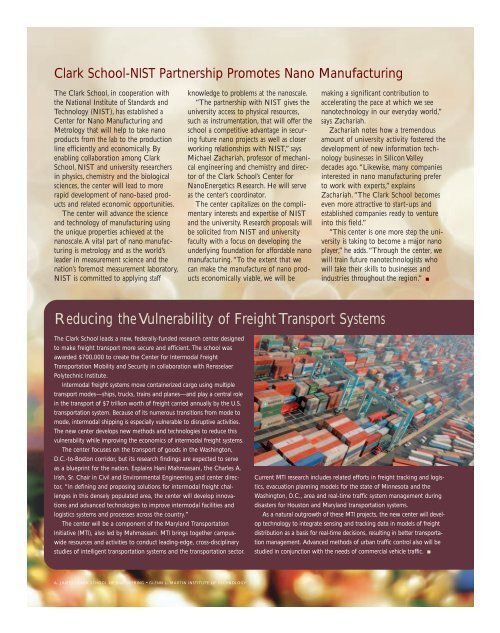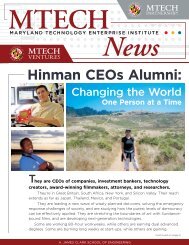Spring 2005 - A. James Clark School of Engineering - University of ...
Spring 2005 - A. James Clark School of Engineering - University of ...
Spring 2005 - A. James Clark School of Engineering - University of ...
Create successful ePaper yourself
Turn your PDF publications into a flip-book with our unique Google optimized e-Paper software.
<strong>Clark</strong> <strong>School</strong>-NIST Partnership Promotes Nano Manufacturing<br />
The <strong>Clark</strong> <strong>School</strong>, in cooperation with<br />
the National Institute <strong>of</strong> Standards and<br />
Technology (NIST), has established a<br />
Center for Nano Manufacturing and<br />
Metrology that will help to take nano<br />
products from the lab to the production<br />
line efficiently and economically. By<br />
enabling collaboration among <strong>Clark</strong><br />
<strong>School</strong>, NIST and university researchers<br />
in physics, chemistry and the biological<br />
sciences, the center will lead to more<br />
rapid development <strong>of</strong> nano-based products<br />
and related economic opportunities.<br />
The center will advance the science<br />
and technology <strong>of</strong> manufacturing using<br />
the unique properties achieved at the<br />
nanoscale. A vital part <strong>of</strong> nano manufacturing<br />
is metrology and as the world’s<br />
leader in measurement science and the<br />
nation’s foremost measurement laboratory,<br />
NIST is committed to applying staff<br />
The <strong>Clark</strong> <strong>School</strong> leads a new, federally-funded research center designed<br />
to make freight transport more secure and efficient. The school was<br />
awarded $700,000 to create the Center for Intermodal Freight<br />
Transportation Mobility and Security in collaboration with Rensselaer<br />
Polytechnic Institute.<br />
Intermodal freight systems move containerized cargo using multiple<br />
transport modes—ships, trucks, trains and planes—and play a central role<br />
in the transport <strong>of</strong> $7 trillion worth <strong>of</strong> freight carried annually by the U.S.<br />
transportation system. Because <strong>of</strong> its numerous transitions from mode to<br />
mode, intermodal shipping is especially vulnerable to disruptive activities.<br />
The new center develops new methods and technologies to reduce this<br />
vulnerability while improving the economics <strong>of</strong> intermodal freight systems.<br />
The center focuses on the transport <strong>of</strong> goods in the Washington,<br />
D.C.-to-Boston corridor, but its research findings are expected to serve<br />
as a blueprint for the nation. Explains Hani Mahmassani, the Charles A.<br />
Irish, Sr. Chair in Civil and Environmental <strong>Engineering</strong> and center director,<br />
“In defining and proposing solutions for intermodal freight challenges<br />
in this densely populated area, the center will develop innovations<br />
and advanced technologies to improve intermodal facilities and<br />
logistics systems and processes across the country.”<br />
The center will be a component <strong>of</strong> the Maryland Transportation<br />
Initiative (MTI), also led by Mahmassani. MTI brings together campuswide<br />
resources and activities to conduct leading-edge, cross-disciplinary<br />
studies <strong>of</strong> intelligent transportation systems and the transportation sector.<br />
A. JAMES CLARK SCHOOL OF ENGINEERING ■ GLENN L. MARTIN INSTITUTE OF TECHNOLOGY<br />
knowledge to problems at the nanoscale.<br />
“The partnership with NIST gives the<br />
university access to physical resources,<br />
such as instrumentation, that will <strong>of</strong>fer the<br />
school a competitive advantage in securing<br />
future nano projects as well as closer<br />
working relationships with NIST,” says<br />
Michael Zachariah, pr<strong>of</strong>essor <strong>of</strong> mechanical<br />
engineering and chemistry and director<br />
<strong>of</strong> the <strong>Clark</strong> <strong>School</strong>’s Center for<br />
NanoEnergetics Research. He will serve<br />
as the center’s coordinator.<br />
The center capitalizes on the complimentary<br />
interests and expertise <strong>of</strong> NIST<br />
and the university. Research proposals will<br />
be solicited from NIST and university<br />
faculty with a focus on developing the<br />
underlying foundation for affordable nano<br />
manufacturing.“To the extent that we<br />
can make the manufacture <strong>of</strong> nano products<br />
economically viable, we will be<br />
making a significant contribution to<br />
accelerating the pace at which we see<br />
nanotechnology in our everyday world,”<br />
says Zachariah.<br />
Zachariah notes how a tremendous<br />
amount <strong>of</strong> university activity fostered the<br />
development <strong>of</strong> new information technology<br />
businesses in Silicon Valley<br />
decades ago.“Likewise, many companies<br />
interested in nano manufacturing prefer<br />
to work with experts,” explains<br />
Zachariah.“The <strong>Clark</strong> <strong>School</strong> becomes<br />
even more attractive to start-ups and<br />
established companies ready to venture<br />
into this field.”<br />
“This center is one more step the university<br />
is taking to become a major nano<br />
player,” he adds.“Through the center, we<br />
will train future nanotechnologists who<br />
will take their skills to businesses and<br />
industries throughout the region.” ■<br />
Reducing the Vulnerability <strong>of</strong> Freight Transport Systems<br />
Current MTI research includes related efforts in freight tracking and logistics,<br />
evacuation planning models for the state <strong>of</strong> Minnesota and the<br />
Washington, D.C., area and real-time traffic system management during<br />
disasters for Houston and Maryland transportation systems.<br />
As a natural outgrowth <strong>of</strong> these MTI projects, the new center will develop<br />
technology to integrate sensing and tracking data in models <strong>of</strong> freight<br />
distribution as a basis for real-time decisions, resulting in better transportation<br />
management. Advanced methods <strong>of</strong> urban traffic control also will be<br />
studied in conjunction with the needs <strong>of</strong> commercial vehicle traffic. ■





